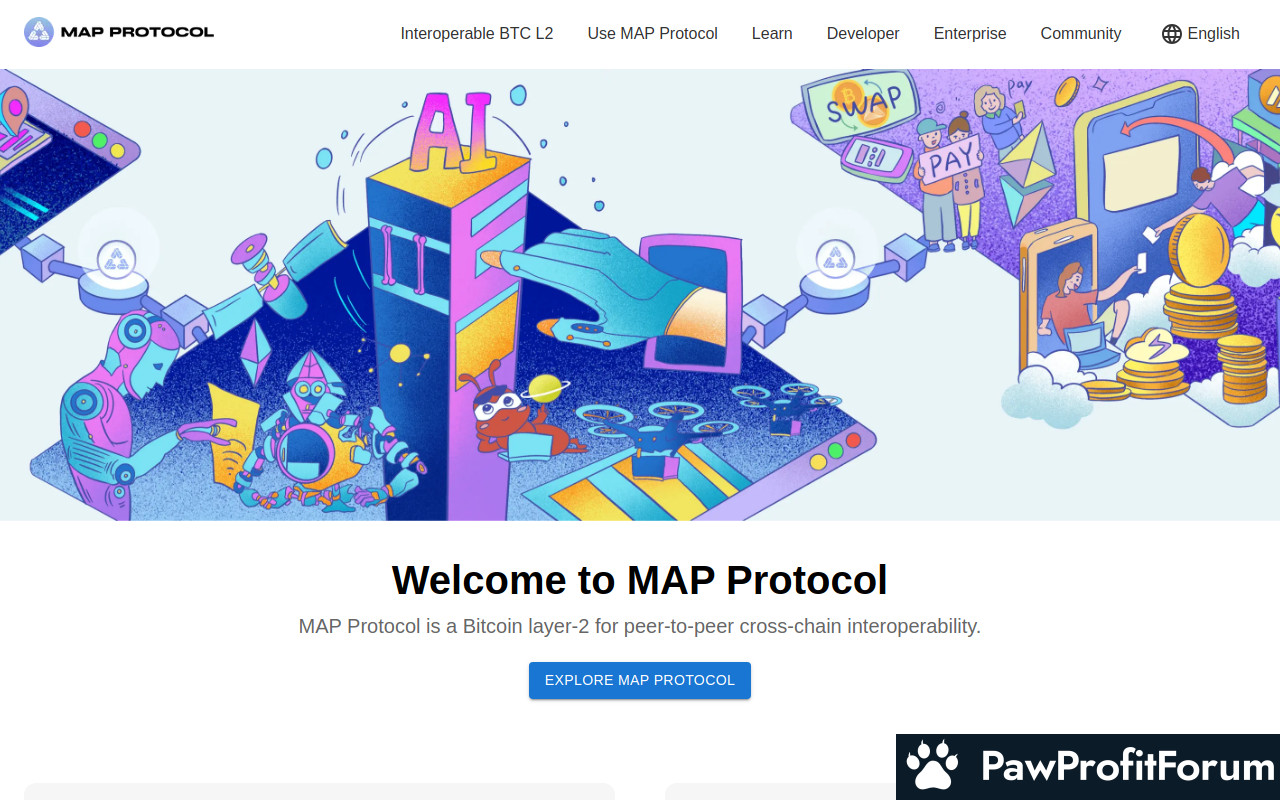MAP Protocol is a Bitcoin layer-2 for peer-to-peer cross-chain interoperability.
The protocol's architecture is designed to prevent long-range attacks by utilizing the robust security mechanisms inherent in the Bitcoin network. This ensures that transactions remain secure, even when interacting with multiple blockchain ecosystems. The open technical design of MAP Protocol encourages community development, fostering a collaborative environment for innovation.
At the heart of MAP Protocol is its commitment to peer-to-peer omnichain infrastructure. This focus allows for seamless communication and transaction execution between different blockchain networks, breaking down barriers that traditionally hinder interoperability. The use of zero-knowledge technology further enhances privacy and security, ensuring that sensitive transaction data remains confidential.
MAP Protocol's emphasis on cross-chain interoperability positions it as a crucial player in the evolving landscape of cryptocurrency. By enabling diverse blockchains to interact without compromising security or efficiency, MAP Protocol is paving the way for a more interconnected and versatile blockchain ecosystem.
The three-layer architecture of MAP Protocol is pivotal in its operation. The first layer is the core blockchain layer, which ensures the fundamental operations and security of the protocol. By utilizing the Bitcoin network, MAP Protocol inherits the security and decentralization that Bitcoin is renowned for. This layer acts as a foundation, providing a secure environment where transactions can be validated and recorded without the risk of tampering by malicious actors.
Moving to the second layer, MAP Protocol employs light clients. Light clients are streamlined versions of full blockchain nodes that require less computational power and storage. They enable users to interact with the blockchain without needing to download the entire blockchain history. This not only enhances efficiency but also makes the protocol more accessible to a wider range of users, from individual enthusiasts to large enterprises.
The third layer introduces Zero-Knowledge (ZK) technology, which plays a crucial role in enhancing privacy and security. ZK technology allows for the verification of transactions without revealing the underlying data. This means that while transactions can be confirmed as valid, the details remain confidential, protecting user privacy. This is particularly important in a world where data security is paramount, offering users peace of mind that their information is safeguarded.
In addition to these layers, MAP Protocol's focus on peer-to-peer interactions ensures that it remains decentralized and resistant to censorship. By enabling direct transactions between users without intermediaries, the protocol reduces points of failure and enhances the overall resilience of the network. This peer-to-peer nature aligns with the foundational principles of blockchain technology, promoting transparency and trust among participants.
Furthermore, MAP Protocol's omnichain infrastructure is designed to facilitate interoperability between different blockchain networks. This is achieved through sophisticated mechanisms that allow for the seamless transfer of assets and data across chains. By bridging the gap between isolated blockchain ecosystems, MAP Protocol empowers users to leverage the strengths of multiple networks, enhancing the utility and reach of blockchain technology.
The security of MAP Protocol is further bolstered by its integration with the Bitcoin network. Bitcoin's proof-of-work consensus mechanism is one of the most secure in the blockchain space, providing a formidable defense against potential attacks. By building on this foundation, MAP Protocol benefits from the extensive computational power and decentralized nature of the Bitcoin network, making it highly resistant to attacks from bad actors.
In essence, the technology behind MAP Protocol is a harmonious integration of advanced blockchain features, designed to provide a secure, efficient, and interoperable platform for users. Its innovative use of light clients and ZK technology, combined with the robust security of the Bitcoin network, positions MAP Protocol as a leading solution in the realm of cross-chain interoperability.
One of the core applications of MAP Protocol is its role in omnichain smart contract development. By enabling smart contracts to operate across multiple chains, developers can create more versatile and robust applications. This is particularly beneficial for decentralized finance (DeFi) platforms, which often need to interact with multiple blockchain ecosystems to offer comprehensive financial services.
MAP Protocol also serves as a platform for decentralized exchanges (DEXs), facilitating the trading of assets across different blockchain networks without the need for a centralized authority. This enhances the liquidity and accessibility of digital assets, making it easier for users to trade and manage their portfolios.
In the realm of Bitcoin, MAP Protocol functions as a layer-2 solution, addressing interoperability needs within the Bitcoin ecosystem. This allows for the integration of Bitcoin with other blockchain networks, expanding its utility beyond simple transactions. Developers can leverage this capability to build innovative solutions that incorporate Bitcoin into broader blockchain applications.
Additionally, MAP Protocol supports omnichain token issuance, enabling the creation and management of tokens that can operate across multiple blockchain networks. This is particularly useful for projects looking to launch tokens that are not confined to a single blockchain, thereby increasing their potential user base and application scope.
In summary, MAP Protocol's real-world applications are diverse, ranging from enhancing cross-chain interoperability to supporting decentralized exchanges and Bitcoin layer-2 solutions. Its infrastructure empowers developers to build decentralized solutions that are not limited by the boundaries of individual blockchains.
In 2019, the release of the MAP Protocol white paper laid the foundation for its ambitious vision. This document outlined the technical framework and strategic goals, setting the stage for future advancements. The white paper's publication was a significant milestone, providing a comprehensive overview of the protocol's capabilities and potential applications.
The following year, MAP Protocol gained recognition by winning the Most Valuable Award at the 2020 Ethereum Hackathon. This accolade highlighted the protocol's innovative approach to cross-chain solutions and underscored its potential to address interoperability challenges within the blockchain ecosystem. The award served as a testament to the project's technical prowess and its ability to capture the attention of the broader crypto community.
Further bolstering its development, MAP Protocol received a grant from the Web3 Foundation. This financial support was instrumental in advancing the protocol's research and development efforts, enabling the team to refine their technology and expand its capabilities. The grant also signified the confidence and support of the Web3 Foundation in MAP Protocol's mission to enhance blockchain interoperability.
Partnerships have played a crucial role in MAP Protocol's evolution. Collaborations with projects such as IERC have been pivotal in expanding its ecosystem and fostering innovation. These partnerships have facilitated the integration of MAP Protocol's technology with other blockchain solutions, enhancing its functionality and reach.
The protocol has also focused on building a robust community and providing extensive resources for developers. By releasing comprehensive documentation and tutorials, MAP Protocol has empowered developers to leverage its technology effectively. This commitment to education and community engagement has been vital in driving adoption and fostering a collaborative environment for innovation.
MAP Protocol's emphasis on cross-chain interoperability has positioned it as a promising project within the cryptocurrency landscape. Its ongoing efforts to establish partnerships and enhance its technology continue to attract attention and interest from the blockchain community. As MAP Protocol progresses, its contributions to the field of blockchain interoperability remain a focal point for developers and enthusiasts alike.
What is MAP Protocol?
MAP Protocol (MAPO) stands as a pioneering force in the realm of blockchain technology, offering a decentralized cross-chain interoperability solution. By leveraging light clients and zero-knowledge (ZK) technology, MAP Protocol facilitates secure and efficient transactions across diverse blockchains. This innovative approach is built upon a Bitcoin layer-2 infrastructure, enhancing its security and scalability.The protocol's architecture is designed to prevent long-range attacks by utilizing the robust security mechanisms inherent in the Bitcoin network. This ensures that transactions remain secure, even when interacting with multiple blockchain ecosystems. The open technical design of MAP Protocol encourages community development, fostering a collaborative environment for innovation.
At the heart of MAP Protocol is its commitment to peer-to-peer omnichain infrastructure. This focus allows for seamless communication and transaction execution between different blockchain networks, breaking down barriers that traditionally hinder interoperability. The use of zero-knowledge technology further enhances privacy and security, ensuring that sensitive transaction data remains confidential.
MAP Protocol's emphasis on cross-chain interoperability positions it as a crucial player in the evolving landscape of cryptocurrency. By enabling diverse blockchains to interact without compromising security or efficiency, MAP Protocol is paving the way for a more interconnected and versatile blockchain ecosystem.
What is the technology behind MAP Protocol?
At the heart of MAP Protocol (MAPO) lies a sophisticated blend of blockchain technologies designed to enhance cross-chain interoperability. This protocol operates as a layer-2 solution on the Bitcoin network, leveraging its robust security features while introducing innovative elements to facilitate seamless interactions across different blockchains. The architecture of MAP Protocol is built upon light clients and Zero-Knowledge (ZK) technology, which together form a resilient and efficient infrastructure.The three-layer architecture of MAP Protocol is pivotal in its operation. The first layer is the core blockchain layer, which ensures the fundamental operations and security of the protocol. By utilizing the Bitcoin network, MAP Protocol inherits the security and decentralization that Bitcoin is renowned for. This layer acts as a foundation, providing a secure environment where transactions can be validated and recorded without the risk of tampering by malicious actors.
Moving to the second layer, MAP Protocol employs light clients. Light clients are streamlined versions of full blockchain nodes that require less computational power and storage. They enable users to interact with the blockchain without needing to download the entire blockchain history. This not only enhances efficiency but also makes the protocol more accessible to a wider range of users, from individual enthusiasts to large enterprises.
The third layer introduces Zero-Knowledge (ZK) technology, which plays a crucial role in enhancing privacy and security. ZK technology allows for the verification of transactions without revealing the underlying data. This means that while transactions can be confirmed as valid, the details remain confidential, protecting user privacy. This is particularly important in a world where data security is paramount, offering users peace of mind that their information is safeguarded.
In addition to these layers, MAP Protocol's focus on peer-to-peer interactions ensures that it remains decentralized and resistant to censorship. By enabling direct transactions between users without intermediaries, the protocol reduces points of failure and enhances the overall resilience of the network. This peer-to-peer nature aligns with the foundational principles of blockchain technology, promoting transparency and trust among participants.
Furthermore, MAP Protocol's omnichain infrastructure is designed to facilitate interoperability between different blockchain networks. This is achieved through sophisticated mechanisms that allow for the seamless transfer of assets and data across chains. By bridging the gap between isolated blockchain ecosystems, MAP Protocol empowers users to leverage the strengths of multiple networks, enhancing the utility and reach of blockchain technology.
The security of MAP Protocol is further bolstered by its integration with the Bitcoin network. Bitcoin's proof-of-work consensus mechanism is one of the most secure in the blockchain space, providing a formidable defense against potential attacks. By building on this foundation, MAP Protocol benefits from the extensive computational power and decentralized nature of the Bitcoin network, making it highly resistant to attacks from bad actors.
In essence, the technology behind MAP Protocol is a harmonious integration of advanced blockchain features, designed to provide a secure, efficient, and interoperable platform for users. Its innovative use of light clients and ZK technology, combined with the robust security of the Bitcoin network, positions MAP Protocol as a leading solution in the realm of cross-chain interoperability.
What are the real-world applications of MAP Protocol?
MAP Protocol (MAPO) stands out as a pivotal player in the cryptocurrency landscape, primarily focusing on cross-chain interoperability. This means it acts as a bridge, allowing different blockchain networks to communicate and interact with each other seamlessly. This capability is crucial for the development of decentralized applications (dApps) that require data and asset transfers across various blockchains, enhancing their functionality and reach.One of the core applications of MAP Protocol is its role in omnichain smart contract development. By enabling smart contracts to operate across multiple chains, developers can create more versatile and robust applications. This is particularly beneficial for decentralized finance (DeFi) platforms, which often need to interact with multiple blockchain ecosystems to offer comprehensive financial services.
MAP Protocol also serves as a platform for decentralized exchanges (DEXs), facilitating the trading of assets across different blockchain networks without the need for a centralized authority. This enhances the liquidity and accessibility of digital assets, making it easier for users to trade and manage their portfolios.
In the realm of Bitcoin, MAP Protocol functions as a layer-2 solution, addressing interoperability needs within the Bitcoin ecosystem. This allows for the integration of Bitcoin with other blockchain networks, expanding its utility beyond simple transactions. Developers can leverage this capability to build innovative solutions that incorporate Bitcoin into broader blockchain applications.
Additionally, MAP Protocol supports omnichain token issuance, enabling the creation and management of tokens that can operate across multiple blockchain networks. This is particularly useful for projects looking to launch tokens that are not confined to a single blockchain, thereby increasing their potential user base and application scope.
In summary, MAP Protocol's real-world applications are diverse, ranging from enhancing cross-chain interoperability to supporting decentralized exchanges and Bitcoin layer-2 solutions. Its infrastructure empowers developers to build decentralized solutions that are not limited by the boundaries of individual blockchains.
What key events have there been for MAP Protocol?
MAP Protocol (MAPO) stands out as a Bitcoin layer-2 solution designed to facilitate peer-to-peer cross-chain interoperability. This innovative approach aims to bridge different blockchain networks, enhancing the seamless transfer of assets and data across various platforms. The journey of MAP Protocol is marked by several pivotal events that have shaped its development and impact in the blockchain space.In 2019, the release of the MAP Protocol white paper laid the foundation for its ambitious vision. This document outlined the technical framework and strategic goals, setting the stage for future advancements. The white paper's publication was a significant milestone, providing a comprehensive overview of the protocol's capabilities and potential applications.
The following year, MAP Protocol gained recognition by winning the Most Valuable Award at the 2020 Ethereum Hackathon. This accolade highlighted the protocol's innovative approach to cross-chain solutions and underscored its potential to address interoperability challenges within the blockchain ecosystem. The award served as a testament to the project's technical prowess and its ability to capture the attention of the broader crypto community.
Further bolstering its development, MAP Protocol received a grant from the Web3 Foundation. This financial support was instrumental in advancing the protocol's research and development efforts, enabling the team to refine their technology and expand its capabilities. The grant also signified the confidence and support of the Web3 Foundation in MAP Protocol's mission to enhance blockchain interoperability.
Partnerships have played a crucial role in MAP Protocol's evolution. Collaborations with projects such as IERC have been pivotal in expanding its ecosystem and fostering innovation. These partnerships have facilitated the integration of MAP Protocol's technology with other blockchain solutions, enhancing its functionality and reach.
The protocol has also focused on building a robust community and providing extensive resources for developers. By releasing comprehensive documentation and tutorials, MAP Protocol has empowered developers to leverage its technology effectively. This commitment to education and community engagement has been vital in driving adoption and fostering a collaborative environment for innovation.
MAP Protocol's emphasis on cross-chain interoperability has positioned it as a promising project within the cryptocurrency landscape. Its ongoing efforts to establish partnerships and enhance its technology continue to attract attention and interest from the blockchain community. As MAP Protocol progresses, its contributions to the field of blockchain interoperability remain a focal point for developers and enthusiasts alike.
Who are the founders of MAP Protocol?
MAP Protocol (MAPO) emerges as a Bitcoin layer-2 solution designed for seamless peer-to-peer cross-chain interoperability. The visionaries behind this innovative project are James Cheng, Kevin Du, and Kari Heh. James Cheng brings a wealth of experience in blockchain technology, having previously contributed to various decentralized projects. Kevin Du, known for his strategic acumen, plays a pivotal role in shaping the protocol's development and adoption strategies. Kari Heh, with a background in cryptographic research, ensures the protocol's security and efficiency. Together, they drive MAP Protocol's mission to enhance blockchain connectivity without any known controversies.| Website | www.mapprotocol.io/ |
| Website | www.mapprotocol.io/article?id=whitepaper |
| Socials | twitter.com/MapProtocol |
| Socials | github.com/mapprotocol |
| Socials | t.me/MAPprotocol |
| Contracts | 0x66D7...509a99 |
| Audits | https://cmc.certik-skynet.com/redirect?project=map-protocol |
| Explorers | www.maposcan.io |
| Wallets | metamask.io/ |



